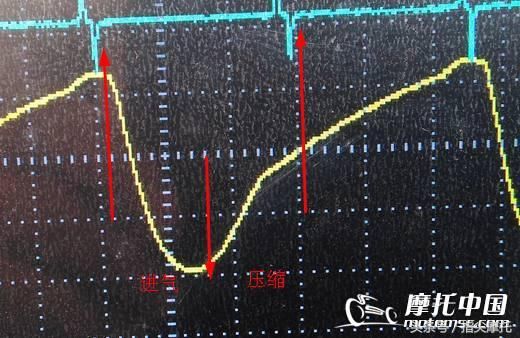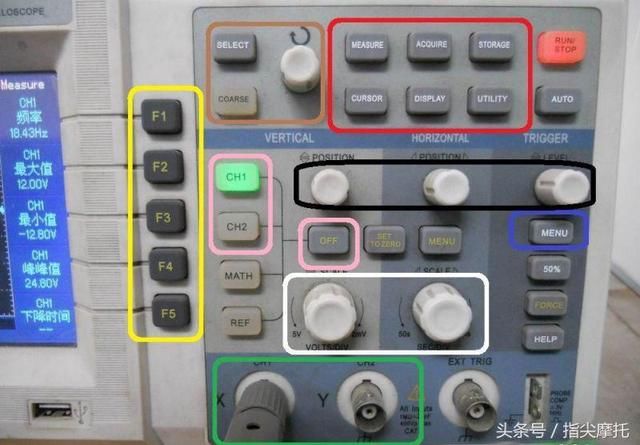The use of oscilloscopes to repair motorcycles is a new tool that has emerged in recent years. It has its own characteristics and its advantages and disadvantages. Learning new tools and new knowledge, we must combine theory with reality, and learn to use it will have a quick entry. Once the fault waveform detected by the oscilloscope leaves theory and reality, it becomes meaningless. Regarding the intake pressure waveform, some netizens asked the carburetor to have no sensor. How to obtain the pressure waveform? This question has already been answered by the article and can be consulted by itself. Some time ago, I published the basic knowledge of the intake pressure waveform. I have not seen the extended reading link later in this article. This chapter mainly talks about the relationship between waveform and actuality, explains the main points of the actual waveform, divides the stroke, and helps everyone understand with practical cases. It is recommended to read the basics of the intake pressure waveform to see this article, it will be easier to understand. We know from the basic knowledge of motorcycle circuits that for a single-seat motorcycle, the magneto is rotated one revolution to generate a trigger signal, and the signal is generated 15 degrees before top dead center. From this, it can be determined that the three points A, C, and E in the figure are top dead centers; the two points B and D are bottom dead centers. Everyone knows that the four-stroke engine completes one work, and the crankshaft rotates two times. The reference picture can be divided as follows: The point A to point B is the intake stroke, and the piston runs from the top dead center to the bottom dead center. At this time, the intake valve is in the open state and the exhaust valve is in the closed state. The point B to point C is the compression stroke, and the piston runs from the bottom dead center to the top dead center. At this time, the intake valve is gradually closed, and the piston compresses the in-cylinder mixture. From point C to point D is the power stroke, the piston runs from the top dead center to the bottom dead center, and the mixture of combustion in the cylinder performs external work. From point D to point E is the exhaust stroke, the piston runs from the bottom dead center to the top dead center, the exhaust valve is open, and the intake valve is still closed, exhausting the exhaust gas. Combined with the stroke division and the valve timing diagram, the working principle of the engine can be clearly understood. These are the basics of waveforms, which are the basis for maintenance work. Some friends have already said this, and there are so many, it seems that they are not very close to the maintenance! Don't worry, combined with the actual content, and then look at a picture. This is a fault waveform. Compared to the normal waveform, the voltage of the waveform rises too fast during the compression stroke, indicating that the air pressure in the intake is rapidly rising. In the normal waveform, the curve voltage of this segment should be slowly rising. A quick rise indicates that other ways of gas have entered the intake. At the same time, the compression stroke piston runs from the bottom dead center to the top dead center, the intake valve is gradually closed, and the mixture is compressed, thereby inferring that the intake valve should be closed tightly, and the compressed mixture is sucked into the intake air. The road causes the air pressure to rise quickly. Do you understand the above text? If you don't understand it, look at it one sentence at a time, look at it three times! Combine it with the graphics, or compare it to the actual test on the actual car. I believe this will help our maintenance. Waveform analysis is to use the subtle changes in the waveform to correlate with the working principle of the engine for analysis. The use of waveform maintenance is not the use of waveforms for measurement, so do not pursue data, it is short and long, in fact, in terms of accuracy, the oscilloscope is not as good as the multimeter. But the advantage of oscilloscope is visual. Therefore, it is important to look at the trend and shape of the graph by using waveform maintenance. This is the key. Only when you look at it more and more, your maintenance feel comes. When is a waveform? Normal, it reveals which part of the fault, you can definitely "pregnancy at a glance", haha. Alloy Tube,Alloy Pipe,Alloy Steel Pipe,Inconel 625 Pipe Tianjin Gongjiantiangang Steel Pipe Co., Ltd. , https://www.gjalloytube.com


